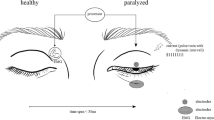Abstract
Six patients with severe ocular side effects caused by therapeutical doses of the tuberculostatic drug ethambutol were investigated during the course of recovery with psychophysical and electrophysiological methods. Three patients developed an optic atrophy with permanently reduced vision as a likely consequence of additional risk factors such as diabetes, alcohol abuse, and reduced kidney function. The severity of the neuritis of the optic nerve was not related to the total intake of ethambutol. The likelihood of a permanent ocular damage increased sharply if the visual acuity had dropped below a value of 1/10. Permanently prolonged latency of the P-100 component was found in visual evoked potentials even in cases with good recovery from ethambutol-induced damage. The recovery of color vision could be monitored very well with the Farnsworth-Munsell 100-Hue Test which revealed a diffuse impairment of color discrimination with a slight prevalence of the red-green axis. In addition to the known disturbances of the red-green antagonistic neurons, it could be demonstrated by measuring transient tritanopia and spectral sensitivity functions that ethambutol also affects the blue-yellow antagonism at the retinal level.
Similar content being viewed by others
References
Carr RE, Henkind P. Ocular manifestations of ethambutol. Arch Ophthalmol 1962; 67: 566–71.
Petrera JE, Fledelius HC, Trojaborg W. Serial pattern evoked potential recording in a case of toxic optic neuropathy due to ethambutol. Electroencephalogr Clin Neurophysiol 1988; 71: 146–9.
Leibold JE. The ocular toxicity of ethambutol and its relation to dose. Ann NY Acad Sci 1966; 135: 904–8.
Barron GJ, Tepper L, Iovine G. Ocular toxicity from ethambutol. Am J Ophthalmol 1974; 77: 256–60.
Pahlitzsch H, Tiburtius H. Augenuntersuchungen bei Behandlung mit dem neuen Tuberkulostatikum Ethambutol-dihydrochlorid Lederle (Myambutol). Klin Monatsbl Augenheilkd 1969; 154: 228–32.
Trusiewicz D. Farnsworth 100-Hue Test in diagnosis of ethambutol-induced damage to optic nerve. Ophthalmologica 1975; 171: 425–31.
Jaeger W, Krastel H, Seiberth V, Koelb R. Ein Farbtafeltest zur Früherkennung und quantitativen Verlaufskontrolle von Ethambutol-Nebeneffekten am Sehnerv: Der “65-Test”. Fortschr Ophthalmol 1985; 82: 571–7.
Polak BC, Leys M, van Lith GH. Blue-yellow colour vision changes as early symptoms of ethambutol oculotoxicity. Ophthalmologica 1985; 191: 223–6.
Bastian A, Brandt HP. Risikofaktoren für das Auftreten von Augenschäden nach Ethambutol-Behandlung. Z Erkr Atmungsorgane 1987; 169: 162–5.
Orou F, Sideroff G, Schabel F. Frequenzunter-suchungen von Optikuserkrankungen im Rahmen der Myambutol®-Behandlung. Klin Monatsbl Augenheilkd 1972; 161: 601–3.
Gross V, Eule H, Hager G. Auswertung einer Toxizitätsstudie bei intermittiernder Ethambutol-Medikation. Klin Monatsbl Augenheilkd 1978; 163: 17–22.
Derka H. Besteht Korrelation zwischen der Höhe der Myambutoldosis und der Häufigkeit der Neuritis Nervi optici? Ophthalmologica 1975; 171: 123–31.
Bouzas A, Kokkinakis K, Papadakis G, Daikos G. La toxicitè oculaire de l'ethambutol. Ophthalmologica 1970; 161: 361–71.
Pau H. Myambutol® (Ethambutol) bedingte Retinoneuritis. Klin Monatsbl Augenheilkd 1985; 187: 25–9.
Mollon JD, Polden PG. An anomaly in the response of the eye to light of short wavelengths. Philos Trans R Soc London Biol 1977; 278: 207–40.
Zrenner E, Gouras P. Characteristics of the blue-sensitive cone mechanism in primate retinal ganglion cells. Visoin Res 1981; 21: 1605–9.
Zrenner E. Neurophysiological aspects of color vision in primates. Stud Brain Funct 1983; 9: 1–218.
Zrenner E, Nowicki J, Adamczyk R. Cone function and cone interaction in hereditary degeneration of the central retina. Doc Ophthalmol 1986; 62: 5–12.
Adachi-Usami E, Kellermann FJ, Makabe R. Visuell evozierte Antworten bei Patienten mit Ethambutol-Schäden. Ber Dtsch Ophthalmol Ges 1974; 72: 181–5.
Zrenner E, Krüger CJ, Baier M. Die Veränderung der spektralen Empfindlichkeit bei Ethambutolschäden. Ber Dtsch Ophthalmol Ges 1981; 78: 1031–7.
Harding GFA, Williams DE, Innes JA. The visual evoked response and visual psychophysics during ethambutol therapy. In: Nodar RH, Barber C, eds. Evoked poentials II: The second international evoked potentials symposium. London: Butterworths Publishers, 1984.
Schmidt IG. Central nervous system effects of ethambutol in monkeys. Ann NY Acad Sci 1966; 135: 759.
Sato S, Sugimoto S, Chiba S. Effects of sodium iodate, iodoacetic acid and ethambutol on electroretinogram and visual evoked potential in rats. J Toxicol Sci 1984; 9: 389–99.
Tamai A. Electrophysiological studies on cases with visual disturbances due to a new antituberculous agent, ethambutol. Acta Soc Ophthalmol Jpn 1966; 73: 86–92.
Zrenner E, Krüger CJ. Ethambutol mainly affects the function of red/green opponent neurons. Doc Ophthalmol Proc Series 1980; 27: 13–25.
van Dijk BW, Spekreijse H. Ethambutol changes the color coding of carp retinal ganglion cells reversibly. Invest Ophthalmol Vis Sci 1983; 24: 128–33.
Wild HM, Kulikowski JJ. Neurotoxic effects of acrylamide on rat retinogeniculate fibres. Behav Brain Res 1984; 13: 201–7.
Jindra LF, von Gruben C, Miliczek KD. The differential effect of ethambutol on M-cell and P-cell contrast sensitivity. Invest Ophthalmol Vis Sci 1988; 28 (Suppl): 300.
Salmon JF, Carmichael TR, Welsh NH. Use of contrast sensitivity measurement in the detection of subclinical ethambutol toxic optic neuropathy. Br J Ophthalmol 1987; 71: 192–6.
Murray IJ, Parry RA, Carden D, Kulikowsky JJ. Human visual evoked potentials to chromatic and achromatic gratings. Clin Vis Sci 1987; 1: 231–244.
Author information
Authors and Affiliations
Rights and permissions
About this article
Cite this article
Nasemann, J., Zrenner, E. & Riedel, K.G. Recovery after severe ethambutol intoxication - psychophysical and electrophysiological correlations. Doc Ophthalmol 71, 279–292 (1989). https://doi.org/10.1007/BF00170977
Issue Date:
DOI: https://doi.org/10.1007/BF00170977




